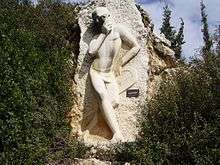Moshe Ziffer

Moshe Ziffer (Hebrew: משה ציפר; born 24 April 1902, died 9 April 1989) was an Israeli artist and sculptor.
Biography
Moshe Ziffer was born in 1902 in Przemyśl, Austria-Hungary. He immigrated to Mandate Palestine in 1919. In 1924–33, he studied sculpture in Vienna, Berlin and Paris. Stone sculptures by Ziffer are on display at the campuses of Tel Aviv University and the Hebrew University of Jerusalem. Ziffer bequeathed his sculpture garden in Safed to the Safed Municipality. He left his home in Tel Aviv and many of his sculptures to Tel Aviv University.
Ziffer died in 1989 in Tel Aviv.
Awards and recognition
Albert Einstein said of Ziffer:"Du bist ein Ziffer und ich bin Ein stein aber du arbeitest mit stein und ich arbeite mit ziffern" ("You are a figure (ziffer—figure, digit, number) and I am a stone (ein stein) but you work with stone and I work with figures"). Einstein also described his work as "simple and noble as the man who created it."
In 1947–48, Ziffer was awarded the Dizengoff Prize in Sculpture,[1] for his design of a wall at Haganah House, Tel Aviv.
Environmental sculptures
- 1938, "Unknown Pioneer", at New York International Fair
- Memorial in honour of the breakthrough at the Burma Road, Hulda
- Memorial in honour of the fighters of the Givati Brigade and members of Kibbutz Nitzanim killed in the Israeli War of Independence, 1948
- Sculpture Garden, Safed
- 1958, "Lot's Wife", Brussels International Exhibition
Portrait busts
Ziffer sculpted busts of Albert Einstein, David Ben-Gurion and Chaim Weizmann.
References
- ↑ "List of Dizengoff Prize laureates" (PDF) (in Hebrew). Tel Aviv Municipality.
Further reading
Ziffer, Moshe; with Jonel Jianou, Arted, Paris, France ISBN 2-85067-056-1
Tal, Miriam (text).—Ziffer Sculpture Garden Artists Colony Safad,
United Artists, Tel Aviv, 1972.
External links
- Ziffer House: Documentation and Research Center of Israeli Visual Arts
- "Moshe Ziffer". Information Center for Israeli Art. Israel Museum. Retrieved 1 February 2012.
- Moshe Ziffer collection at the Israel Museum. Retrieved 1 February 2012